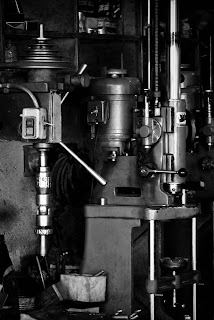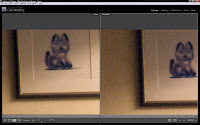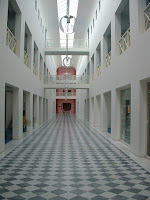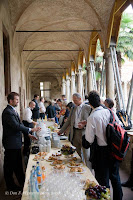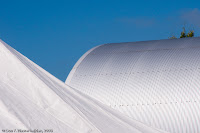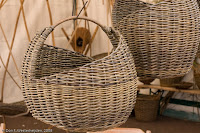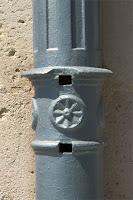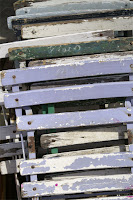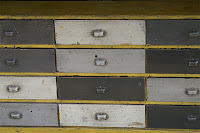Months ago I mentioned Dutch 20th century painter Piet Mondriaan a few times in this blog series. Famous—or notorious?—for his ultimately abstract pictures with squares and rectangles in red, blue and yellow, what has he got to do with photography, and of landscapes to boot? That is a long story. Mondriaan (outside the Netherlands also spelled Mondrian) started out, around 1900, as a pretty conventional painter. He lived in very interesting times, however, when painting was being revolutionised, not least because of the invention of photography, over half a century before. Cézanne, whom I also mentioned a few times for his problematising the relation of the painting as a canvas with depicted reality, was only the beginning. Fauvists and Cubists followed the (post-)Expressionists and then this other Dutchman, Theo van Doesburg, invented De Stijl. Mondriaan's extremely pure application of the Stijl principles make up his most famous paintings of the 1920s and 1930s, with rectangles in only the primary colours (for paint): red, yellow and blue, on a fond of white with black stripes.
I guess that I was like many people who at first could not find any sense or beauty in these utterly abstract paintings, but after reading a little and especially after seeing—quite a few years ago now—a chronologically organised overviews exhibition of Mondriaan's paintings in The Hague, I started to find them fascinating and, yes, beautiful. The big fascination was to see Mondriaan struggle for finding beauty in the landscape and trying to express beauty without the viewer being distracted by the representation. I plan to get back to this movement later on, but let me here look at an early stage of his quest.
 You can paint—or photograph, for that matter—the windmill in Domburg against the evening sky (see these and a few more of his paintings at the website of the Domburg tourist agency). Mondriaan did that in 1909 in a more or less naturalistic style (first picture), although the blue colour of the mill as a suggestion of the late evening light could not have been made ten years earlier in the history of painting. I wonder, by the way, if that blue was a correct representation of how our eyes work: in dark circumstances, the receptors for colour (cone cells) in the retina are almost inactive and we only see light-and-dark (rod cells) —any strong colouring then is fantasy, I'd say. But let's look at how he painted the same mill in 1911: against again a night-blue sky there is a red shape with details in the sky's blue (a window and the axis of the mill's wings). In the tints of blue we see a vague differentiation between sky and earth; similarly, a darker shade of red suggests some volume in the mill. This is not yet an abstract painting, but clearly Mondriaan made a lot of steps in his thoughts in those two years. No longer even an effort at more or less naturalistic colouring: the blue of the sky is way too blue for that and the earth should not be the same hue of blue and just a bit darker. And most of all, of course: the mill has turned red! We have two of his later three primary colours here, with much contrast. It is all about strong shape and strong colour; the viewer must be struck at the very first moment by a strong impression. It is not about being true to what the painter's eye saw. For me, that was the eye-opener about this painting: think of what the viewer will experience!
You can paint—or photograph, for that matter—the windmill in Domburg against the evening sky (see these and a few more of his paintings at the website of the Domburg tourist agency). Mondriaan did that in 1909 in a more or less naturalistic style (first picture), although the blue colour of the mill as a suggestion of the late evening light could not have been made ten years earlier in the history of painting. I wonder, by the way, if that blue was a correct representation of how our eyes work: in dark circumstances, the receptors for colour (cone cells) in the retina are almost inactive and we only see light-and-dark (rod cells) —any strong colouring then is fantasy, I'd say. But let's look at how he painted the same mill in 1911: against again a night-blue sky there is a red shape with details in the sky's blue (a window and the axis of the mill's wings). In the tints of blue we see a vague differentiation between sky and earth; similarly, a darker shade of red suggests some volume in the mill. This is not yet an abstract painting, but clearly Mondriaan made a lot of steps in his thoughts in those two years. No longer even an effort at more or less naturalistic colouring: the blue of the sky is way too blue for that and the earth should not be the same hue of blue and just a bit darker. And most of all, of course: the mill has turned red! We have two of his later three primary colours here, with much contrast. It is all about strong shape and strong colour; the viewer must be struck at the very first moment by a strong impression. It is not about being true to what the painter's eye saw. For me, that was the eye-opener about this painting: think of what the viewer will experience!
 Bonus puzzle for you, dear readers (and to me!): interesting that Mondriaan chose to keep the sky coloured close to nature and to think that the man-made addition to the landscape was the more mutable one, of which he could change the colour. Why did he not do it the other way around: a darkish, bluish or perhaps black mill against a red sky?
Bonus puzzle for you, dear readers (and to me!): interesting that Mondriaan chose to keep the sky coloured close to nature and to think that the man-made addition to the landscape was the more mutable one, of which he could change the colour. Why did he not do it the other way around: a darkish, bluish or perhaps black mill against a red sky?
Another bonus, as an aside: does Mondriaan's red mill show influence of photography in the strong perspective as if the mill was photographed through a wide-angle lens? Ans dhat about his cutting of the wings, is that not also in imitation of an 'error' of photography? Or am I anachronistically over-interpreting things here? For instance, did they have such strong wide-angle lenses in 1911?






